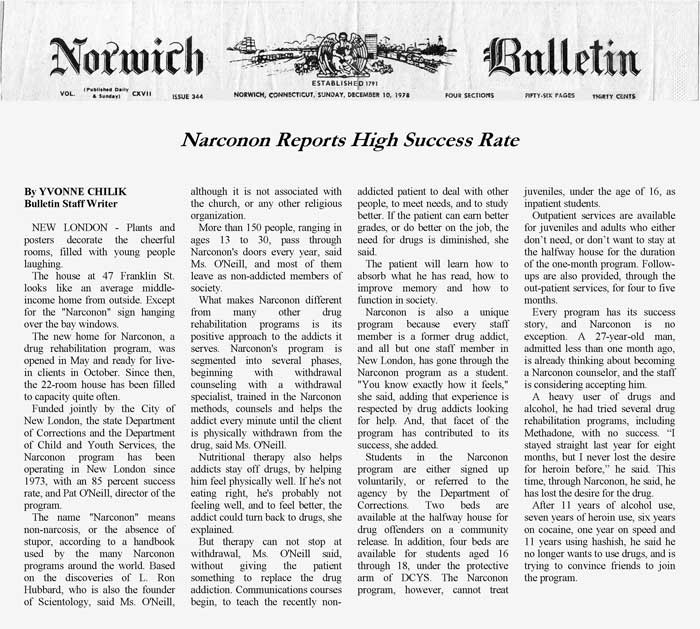Narconon Reports High Success Rate

NEW LONDON — Plants and posters decorate the cheerful rooms, filled with young people laughing.
The house at 47 Franklin St. looks like an average middle-income home from outside. Except for the “Narconon” sign hanging over the bay windows.
The new home for Narconon, a drug rehabilitation program, was opened in May and ready for live-in clients in October. Since then, the 22-room house has been filled to capacity quite often.
Funded jointly by the City of New London, the state Department of Corrections and the Department of Child and Youth Services, the Narconon program has been operating in New London since 1973, with an 85 percent success rate, and Pat O’Neill, director of the program.
The name “Narconon” means non-narcosis, or the absence of stupor, according to a handbook used by the many Narconon programs around the world. Based on the discoveries of L. Ron Hubbard, who is also the founder of Scientology, said Ms. O’Neill, although it is not associated with the church, or any other religious organization.
More than 150 people, ranging in ages 13 to 30, pass through Narconon’s doors every year, said Ms. O’Neill, and most of them leave as non-addicted members of society.
What makes Narconon different from many other drug rehabilitation programs is its positive approach to the addicts it serves. Narconon’s program is segmented into several phases, beginning with withdrawal counseling with a withdrawal specialist, trained in the Narconon methods, counsels and helps the addict every minute until the client is physically withdrawn from the drug, said Ms. O’Neill.
Nutritional therapy also helps addicts stay off drugs, by helping him feel physically well. If he’s not eating right, he’s probably not feeling well, and to feel better, the addict could turn back to drugs, she explained.
But therapy can not stop at withdrawal, Ms. O’Neill said, without giving the patient something to replace the drug addiction. Communications courses begin, to teach the recently non-addicted patient to deal with other people, to meet needs, and to study better. If the patient can earn better grades, or do better on the job, the need for drugs is diminished, she said.
The patient will learn how to absorb what he has read, how to improve memory and how to function in society.
Narconon is also a unique program because every staff member is a former drug addict, and all but one staff member in New London, has gone through the Narconon program as a student. “You know exactly how it feels,” she said, adding that experience is respected by drug addicts looking for help. And, that facet of the program has contributed to its success, she added.
Students in the Narconon program are either signed up voluntarily, or referred to the agency by the Department of Corrections. Two beds are available at the halfway house for drug offenders on a community release. In addition, four beds are available for students aged 16 through 18, under the protective arm of DCYS. The Narconon program, however, cannot treat juveniles, under the age of 16, as inpatient students.
Outpatient services are available for juveniles and adults who either don’t need, or don’t want to stay at the halfway house for the duration of the one-month program. Follow-ups are also provided, through the out-patient services, for four to five months.
Every program has its success story, and Narconon is no exception. A 27-year-old man, admitted less than one month ago, is already thinking about becoming a Narconon counselor, and the staff is considering accepting him.
A heavy user of drugs and alcohol, he had tried several drug rehabilitation programs, including Methadone, with no success. “I stayed straight last year for eight months, but I never lost the desire for heroin before,” he said. “This time, through Narconon”, he said, he has lost the desire for the drug.
After 11 years of alcohol use, seven years of heroin use, six years on cocaine, one year on speed and 11 years using hashish, he said he no longer wants to use drugs, and is trying to convince friends to join the program.
See also: